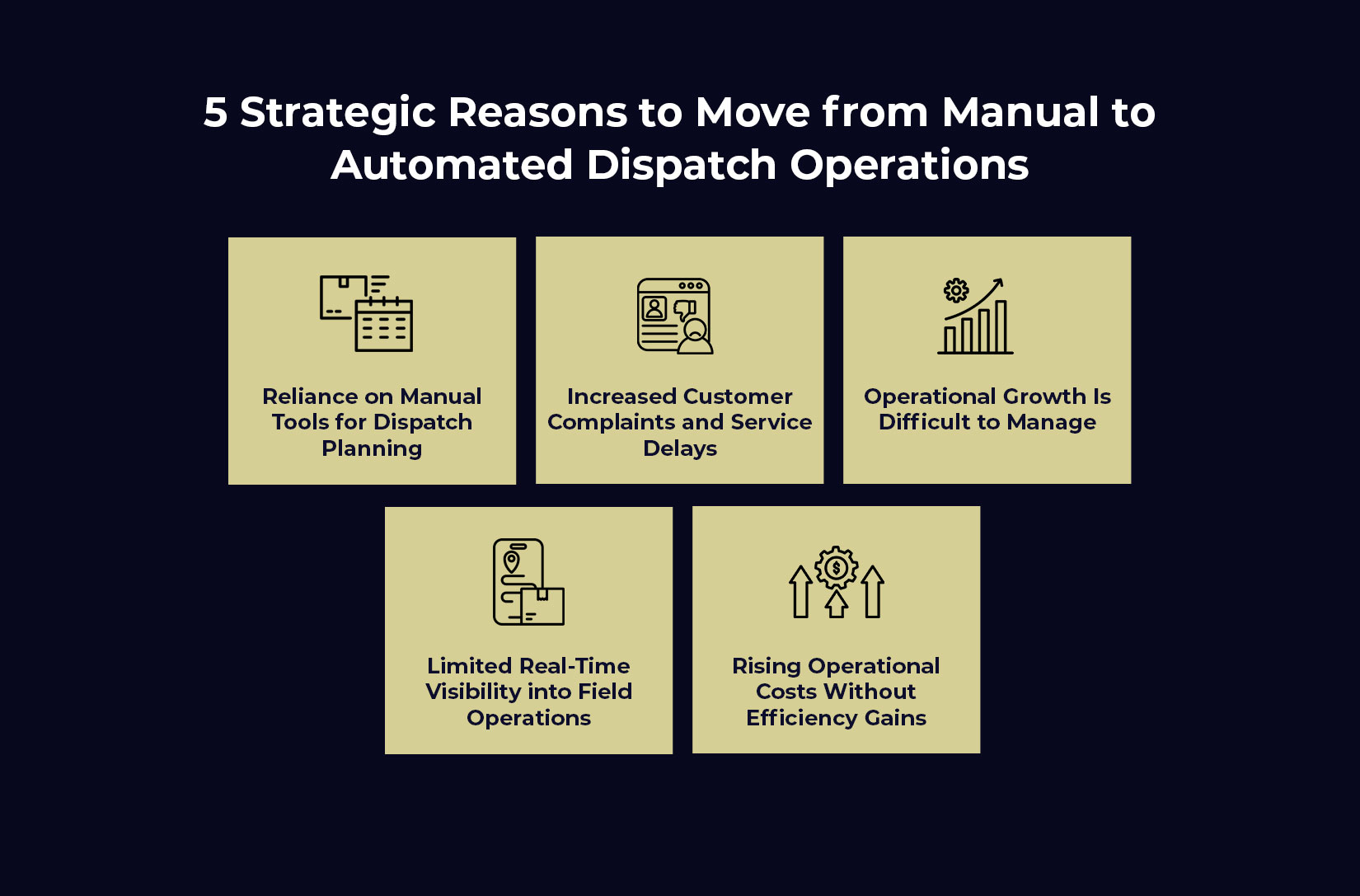
5 Signs It’s Time to Upgrade to Dispatch Automation Software
In logistics and field operations, satisfied customers and missed SLAs are separated by efficient dispatching. However, there are many businesses that still rely on outdated manual processes that slow down operations and increase errors. With the rising customer expectations and operational complexity, the shift towards a robust dispatch automation software is inevitable.
But its also important to know and understand when is the right time to make the switch. This blog will focus on 5 clear/important signs indicating the business is ready for the upgrade. The blog will also discuss how dispatch automation software will boost productivity, accuracy and customer satisfaction.
5 Strategic Reasons to Move from Manual to Automated Dispatch Operations

1. Reliance on Manual Tools for Dispatch Planning:
In today’s fast paced environment manual planning cannot survive. A business cannot function on excel files and dry-ease boards. They are prone to human error and cannot provide real-time visibility.
As per a report by PwC, 61% of logistics companies specify outdated technology as a barrier to growth. When the dispatcher manually assigning tasks, there are chances of assigning the wrong driver, miscalculating time windows or missing critical information.
A dispatch automation solution removes guesswork. It matches the drivers to tasks based on real-time data, ensuring faster, more accurate assignments. This improves operational efficiency and reduces customer complaints due to missed deliveries or delays.
2. Increased Customer Complaints and Service Delays:
Customer satisfaction depends on one key factor which is reliability. The reputation of the business can be seriously affected with late deliveries, incorrect ETAs or unresponsive drivers. As per Capgemini, 97% of customers believe on-time delivery is important for their overall satisfaction. If the customer support is attending more complaints than compliments, its a sign that the dispatch operations are lagging.
A dispatch automation software gives the business real-time tracking, dynamic ETAs and proactive notifications. It empowers the dispatchers to make smarter, faster decisions when delays happened due to weather, traffic or last-minute changes. A study by Logistics Management states businesses using dispatch automation saw up to 30% improvement in on-time performance.
3. Operational Growth Is Difficult to Manage:
If your business is growing, but the dispatch operations are not able to keep up, its a sign to change. Scalability is one of the biggest advantages of a dispatch automation software. As the fleet grows, automation ensures that the operations don’t fall under pressure. Route planning, driver assignment, customer communication and compliance all scale with the business.
With the best software, you can optimize routes in seconds, auto-assign tasks based on availability and proximity. It can also predict delivery patterns using AI and machine learning. If you are facing frequent scheduling conflicts, delays in driver dispatch or difficulty managing multiple regions or teams, its time to upgrade.
4. Limited Real-Time Visibility into Field Operations:
If you are not able to confidently say, where the drivers are or will a delivery be late, you are operating blind. Manual systems offer limited visibility which can lead to delays, miscommunication and unnecessary struggles. A robust dispatch automation system offers end-to-end visibility. It also enables to track drivers in real-time, monitor task status and ETAs, identify bottlenecks instantly.
This transparency will help the business run smoothly. It also helps to keep the customers in the loop and gives managers the data they need to make better decisions. Real-time tracking can reduce customer service calls by up to 60%.
5. Rising Operational Costs Without Efficiency Gains:
Manual dispatching is not just slow, its expensive. Labor costs rise, wastes in fuel and poor planning can lead to missed SLAs and potential penalties. The software streamlines everything: intelligent route optimization cuts fuel costs, dynamic scheduling reduces idle time, automated communications free up staff.
McKinsey reports that logistics businesses saw cost reduction of 15-20% using automation and AI. Pay attention to indicators: rising overtime costs for dispatchers, excessive fuel spend and more frequent missed delivery windows. A modern dispatch automation platform, helps the business to do more with less, without sacrificing quality.
Choosing the Best Dispatch Automation Software
Identifying the indicators is the first step. Once you identify the indicators, you will need to choose the solutions that work best for you. The best dispatch automation software should include:
– Real-time route optimization.
– Smart task assignment.
– Automated alerts and notifications.
– Connection to your TMS or ERP with data integration.
– Scalable design for growth.
Do not be fooled by bells and whistles, look for features that address your actual pain points. Look for platforms that have demonstrated outcomes in your specific industry; look for usability and customer support.
Conclusion
If you notice one or more of these family signs in your day-to-day operations, please don’t take it lightly. The logistics industry is only going to get faster, more complicated, and highly competitive. Dispatch automation software is not just an update, it is a business requirement.
With a modern dispatch automation solution, you will have the speed, the scalability, and the accuracy to run your operations not just today, but also thrive in a high-demand world. And if you choose the best dispatch automation software, you’re delving into the world of reliable long-term success. So, book a demo with LogiNext Solutions fix your long term success. Click on the red button to know more.
40







@LogiNext